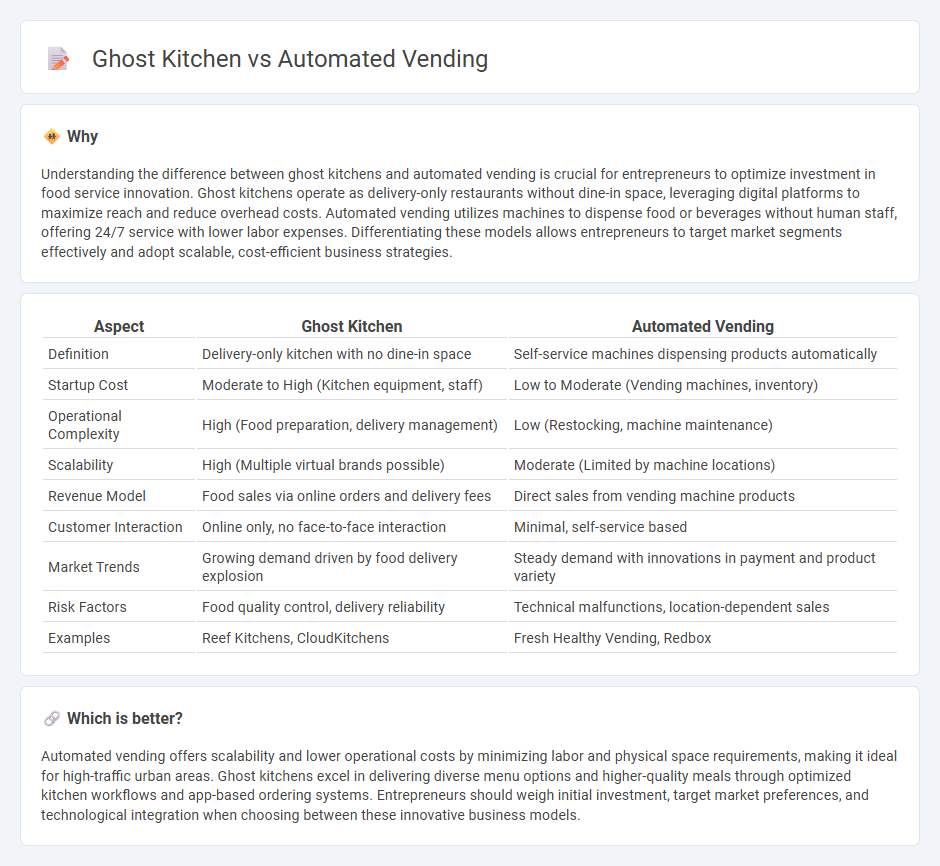
Ghost kitchens leverage off-site food preparation exclusively for delivery, reducing overhead and expanding restaurant reach, while automated vending machines offer contactless, on-demand food access through advanced robotics and payment systems. Both innovations cater to evolving consumer preferences for convenience and speed in urban markets experiencing rapid growth. Explore how these trends reshape the future of foodservice and entrepreneurial opportunities.
Why it is important
Understanding the difference between ghost kitchens and automated vending is crucial for entrepreneurs to optimize investment in food service innovation. Ghost kitchens operate as delivery-only restaurants without dine-in space, leveraging digital platforms to maximize reach and reduce overhead costs. Automated vending utilizes machines to dispense food or beverages without human staff, offering 24/7 service with lower labor expenses. Differentiating these models allows entrepreneurs to target market segments effectively and adopt scalable, cost-efficient business strategies.
Comparison Table
| Aspect | Ghost Kitchen | Automated Vending |
|---|---|---|
| Definition | Delivery-only kitchen with no dine-in space | Self-service machines dispensing products automatically |
| Startup Cost | Moderate to High (Kitchen equipment, staff) | Low to Moderate (Vending machines, inventory) |
| Operational Complexity | High (Food preparation, delivery management) | Low (Restocking, machine maintenance) |
| Scalability | High (Multiple virtual brands possible) | Moderate (Limited by machine locations) |
| Revenue Model | Food sales via online orders and delivery fees | Direct sales from vending machine products |
| Customer Interaction | Online only, no face-to-face interaction | Minimal, self-service based |
| Market Trends | Growing demand driven by food delivery explosion | Steady demand with innovations in payment and product variety |
| Risk Factors | Food quality control, delivery reliability | Technical malfunctions, location-dependent sales |
| Examples | Reef Kitchens, CloudKitchens | Fresh Healthy Vending, Redbox |
Which is better?
Automated vending offers scalability and lower operational costs by minimizing labor and physical space requirements, making it ideal for high-traffic urban areas. Ghost kitchens excel in delivering diverse menu options and higher-quality meals through optimized kitchen workflows and app-based ordering systems. Entrepreneurs should weigh initial investment, target market preferences, and technological integration when choosing between these innovative business models.
Connection
Ghost kitchens and automated vending systems revolutionize entrepreneurship by minimizing operational costs and expanding scalable food service models. Both leverage technology to optimize efficiency; ghost kitchens use centralized kitchen spaces for delivery-only meals while automated vending offers contactless, on-demand food access. Entrepreneurs harness these innovations to meet growing consumer demand for convenience and rapid service in a competitive market.
Key Terms
Self-service technology
Self-service technology in automated vending machines enhances customer convenience by providing quick, contactless access to a wide range of products, leveraging AI for inventory management and personalized recommendations. Ghost kitchens utilize self-service technology through app-based ordering and automated food preparation systems, streamlining operations to reduce wait times and operational costs. Explore how these innovations revolutionize the food service industry and customer experience.
Delivery-only model
Automated vending machines and ghost kitchens both streamline the delivery-only food service model, with automated vending offering hyper-localized, contactless food dispensing via smart machines, while ghost kitchens leverage centralized commercial kitchens dedicated solely to fulfilling online orders. Automated vending excels in speed and minimal labor costs but is limited by menu variety and storage capacity, whereas ghost kitchens provide extensive menu options and scalability at the cost of higher operational complexity. Explore how these innovative models are transforming food delivery landscapes and which fits your business goals best.
Scalability
Automated vending systems offer rapid scalability with minimal labor costs, leveraging technology for efficient product distribution across multiple locations. Ghost kitchens scale by optimizing delivery-only food production, reducing overhead compared to traditional restaurants and quickly adapting to changing consumer demand. Explore how these innovations transform food service scalability and operational efficiency.
Source and External Links
Smart Vending Machines: The Future of Automated Retail - Automated vending machines have evolved into AI-driven retail hubs offering everything from consumer electronics to pharmaceuticals, providing personalized, cashless, and 24/7 shopping experiences that reshape retail and create new revenue streams for brands.
Smart Vending & Automated Retail - Smart vending platforms leverage AI and 5G connectivity for remote management, real-time sales and inventory tracking, personalized product recommendations, and enhanced unmanned retail experiences through facial recognition and data analytics.
Automated Vending Machine - IT Asset Distribution Solutions - Spark automated vending machines reduce staffing needs and operating costs by enabling 24/7 self-service access to products, facilitating effortless market expansion and optimized retail operations with intelligent vending technology.
 dowidth.com
dowidth.com